How long does a moka pot take to brew that perfect cup of Italian-style coffee? If you’ve recently purchased this stovetop coffee maker or are considering adding one to your kitchen arsenal, understanding the brewing time is essential for planning your morning routine.
Most coffee enthusiasts appreciate the moka pot for its rich, espresso-like brew, but timing can vary depending on several factors. From heat source and grind size to water temperature and pot size, multiple variables affect how quickly you’ll enjoy that aromatic caffeine boost. Whether you’re a busy professional trying to streamline your morning or a coffee aficionado seeking the perfect brew time, knowing what to expect from your moka pot will help you master this classic brewing method.
What Is a Moka Pot and How Does It Work
A Moka pot is an Italian stovetop coffee maker that produces rich, concentrated coffee similar to espresso. Invented by Alfonso Bialetti in 1933, this iconic octagonal brewer has become a staple in many households worldwide due to its reliability and distinctive brewing method.
Moka pots operate using simple physics. The brewing chamber consists of three main components: a bottom chamber for water, a middle funnel-shaped filter basket for coffee grounds, and a top chamber where the brewed coffee collects. When heated on a stovetop, pressure builds in the bottom chamber as water approaches boiling point, forcing hot water up through the coffee grounds and into the top chamber.
The brewing process creates a distinctive gurgling sound as the coffee completes its journey. This characteristic noise serves as an audio cue that your coffee is nearly ready. Many coffee enthusiasts, including our own Rikki Manny, describe this sound as “the morning alarm that promises something delicious is moments away.”
Moka pots come in various sizes, typically measured by the number of cups they produce (1, 3, 6, 9, or 12 cups). The standard “cup” in Moka pot measurements equals approximately 2 ounces of coffee, though this varies slightly between manufacturers. Materials range from traditional aluminum to stainless steel, with some modern variations offering induction-compatible bases.
Unlike drip coffee makers, Moka pots extract coffee under pressure (1-2 bars compared to espresso machines’ 9 bars), resulting in a stronger brew with more pronounced flavors and body. This brewing method extracts more oils and compounds from the coffee beans, creating that distinctive robust flavor profile that falls between drip coffee and espresso in strength and concentration.
Average Brewing Time for a Moka Pot
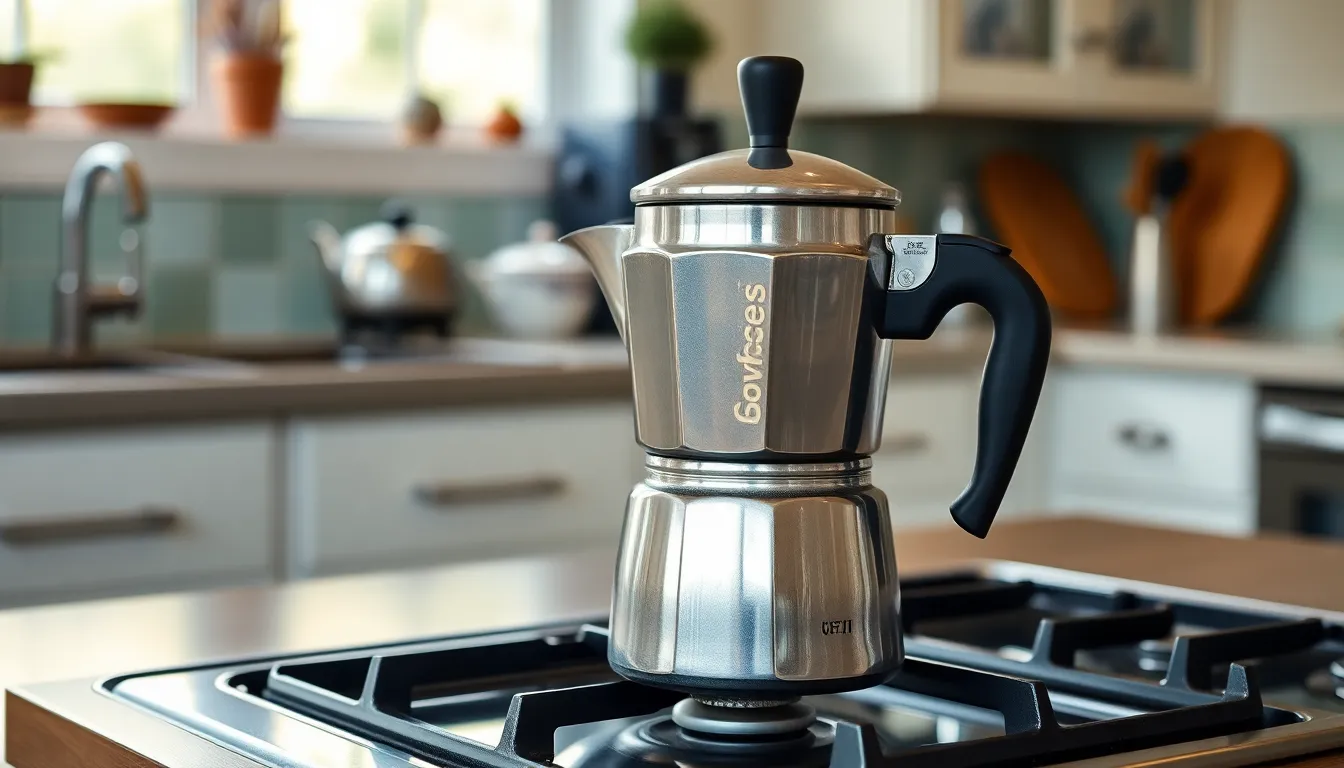
A typical moka pot completes its brewing cycle in 5 to 10 minutes from the moment it’s placed on the stove until the coffee finishes brewing. Most common household moka pots (3-cup or 6-cup sizes) narrow this timeframe to about 5 to 8 minutes for the complete brewing process.
Factors That Affect Brewing Speed
The brewing speed of your moka pot varies based on several key factors that affect its performance. Moka pot size plays a important role—smaller 3-cup models brew within 5-8 minutes, while larger pots require additional time to complete the brewing cycle. Heat source intensity directly impacts brewing time, with higher heat settings accelerating the process but potentially forcing ground coffee particles through the filter, resulting in unwanted grittiness in your cup.
Grind size consistency affects both flavor and flow rate—an ideal fine grind (similar to sand) ensures optimal extraction, while grounds that are too fine can slow brewing or cause clogging, and overly coarse grounds produce weak, fast-brewing coffee. Starting with hot or preheated water cuts down brewing time significantly compared to beginning with cold water. Material composition and stove compatibility also matter—aluminum pots work well on gas or electric stoves but require adapters for induction, while magnetic stainless steel pots work directly on induction stovetops with potentially different heating efficiency.
Typical Time Range to Expect
The brewing process follows a predictable timeline with distinct phases throughout the brewing cycle. Initial heating takes approximately 2 to 4 minutes from placing the pot on the heat source until coffee begins to flow, depending on your stove power and pot size. Complete brewing cycles for standard 3 to 6 cup moka pots typically finish within 5 to 8 minutes total from start to finish.
High heat settings can reduce brewing time to around 2-3 minutes, but this aggressive approach often compromises coffee quality and flavor development. The brewing concludes with a distinctive gurgling sound that signals the final moments of extraction, serving as your audio cue that the coffee is nearly ready to serve.
| Moka Pot Brewing Timeline | Time Range |
|---|---|
| Total brewing time | 5-10 minutes |
| Common size (3-6 cup) brewing time | 5-8 minutes |
| Time until coffee begins flowing | 2-4 minutes |
| High heat brewing (not recommended) | 2-3 minutes |
The Step-by-Step Moka Pot Brewing Process with Timing
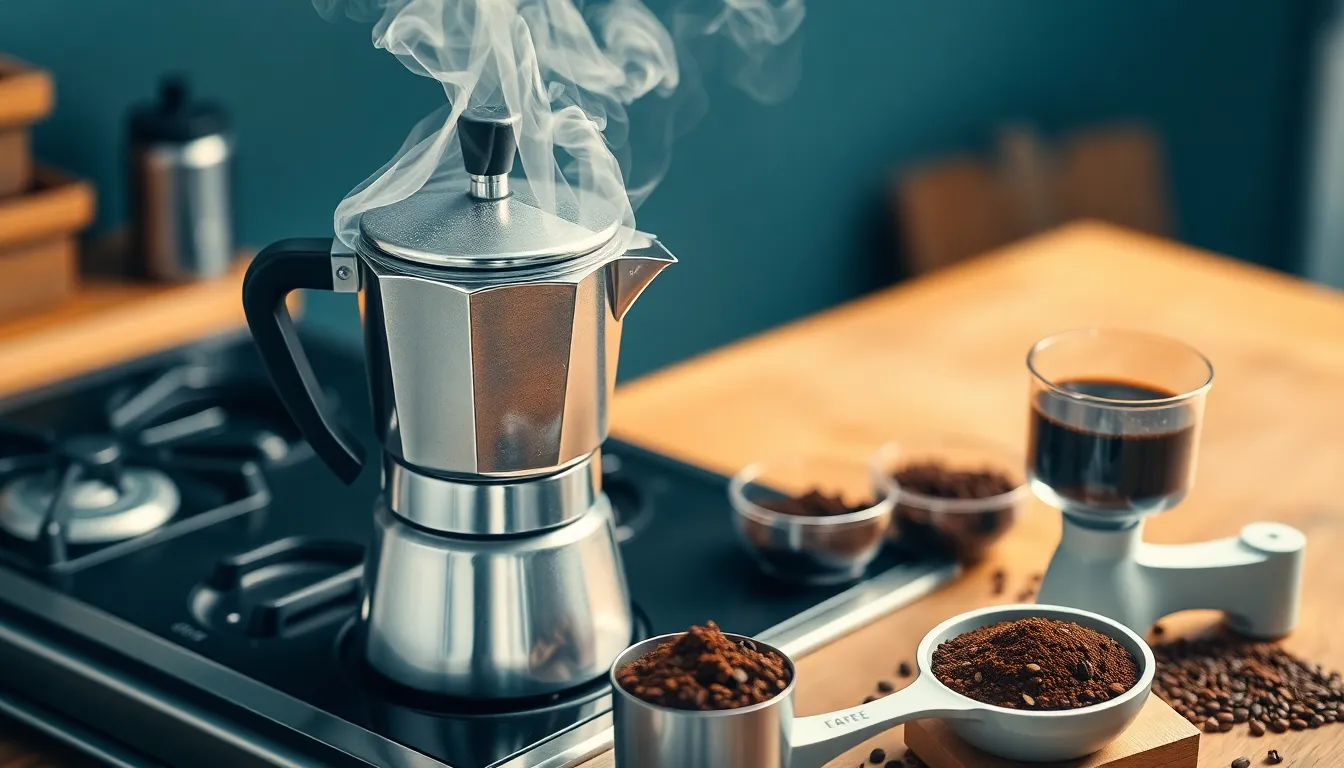
The moka pot brewing process follows distinct phases with exact timing requirements for optimal extraction. Understanding each step and its duration helps you achieve the perfect cup of coffee every time.
Preparation Time: Water and Coffee
Proper preparation sets the foundation for successful moka pot brewing. Grind approximately 20-22 grams of coffee for a standard 6-cup moka pot, aiming for a consistency that’s finer than pour-over but coarser than espresso. Fill the bottom chamber with water up to the fill line (about 1-1.5 cm from the top), then insert the filter basket and add your ground coffee. Level the grounds without compressing them, as this ensures even water flow during extraction. Complete the assembly by securely screwing on the top chamber. This preparation phase typically takes just a few minutes but significantly impacts your final brew quality.
Heating and Extraction Phase
The heating and extraction phase represents the core of the moka pot brewing process, lasting approximately 5-10 minutes total. Place your assembled pot on a stove over low to medium heat, ensuring flames don’t extend beyond the base when using a gas stove. Coffee extraction begins about 2-5 minutes after heating starts, depending on your stove type and pot size. Monitor the brewing carefully as coffee begins flowing into the upper chamber in a steady stream. The flow rate indicates extraction quality—reduce heat if the flow appears explosive or increase it if too slow. The color of the stream provides important feedback; a lightening color accompanied by gurgling sounds signals it’s time to remove the pot from heat before the coffee burns.
Final Steps and Serving
Completing the brewing process correctly preserves the rich flavors developed during extraction. Close the lid as soon as you hear gurgling sounds and remove the pot from heat. Serving the coffee immediately delivers the best flavor experience, though transferring to an insulated carafe works well if you can’t serve right away. For future brews, adjust your technique based on taste results: use a finer grind or lower heat to combat sourness, try a coarser grind or higher heat to reduce bitterness, and always remove the pot earlier to avoid burnt flavors. While some people accelerate brewing to 2-3 minutes using high heat, this approach often compromises flavor quality and isn’t recommended for those seeking the authentic moka pot experience.
Common Mistakes That Increase Brewing Time
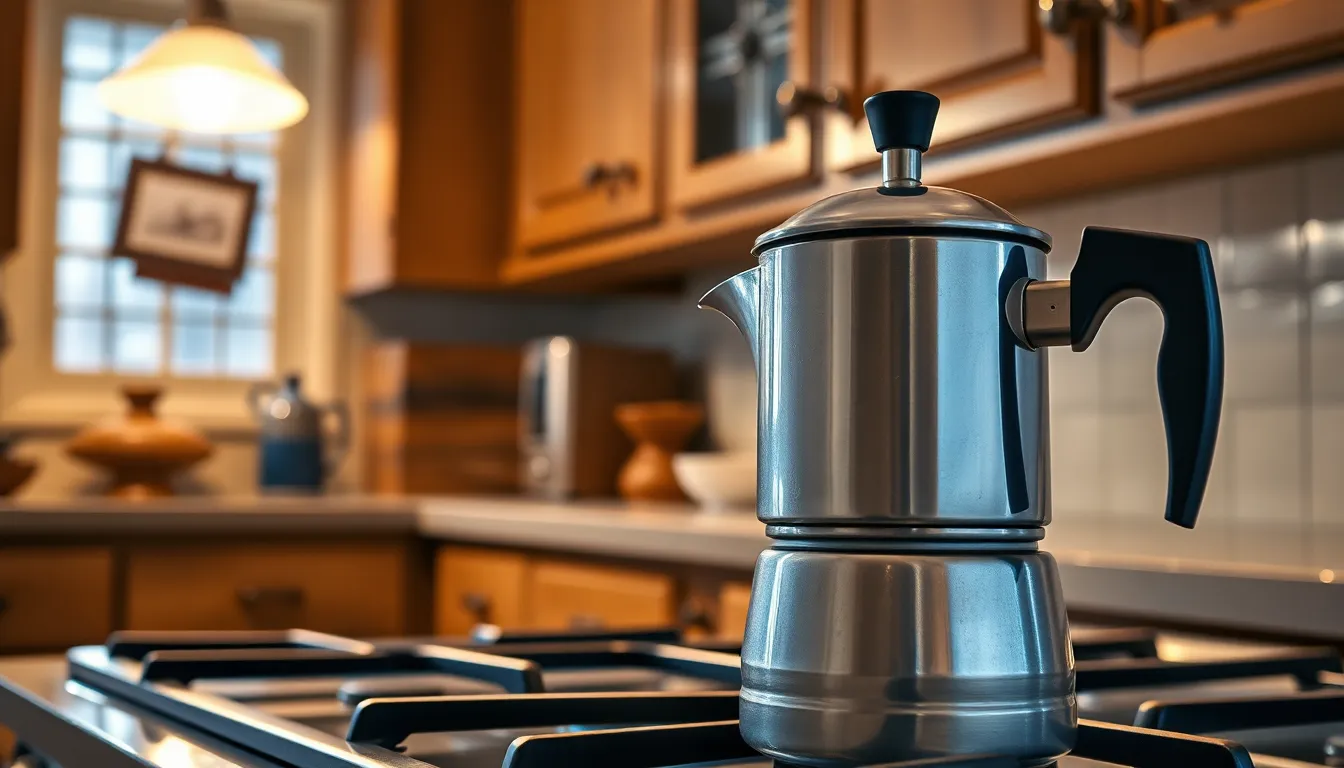
Brewing coffee with a moka pot shouldn’t take forever, yet several common errors can unnecessarily extend your brewing time. Using insufficient heat ranks among the most frequent mistakes, as a flame that’s too low fails to generate adequate pressure, resulting in a sluggish extraction process.
Starting with cold water significantly extends your brew time compared to beginning with pre-heated water. Research shows that using hot water (around 208°F or 98°C) not only speeds up the process but also prevents your coffee grounds from overheating during the initial heating phase.
Incorrect grind size creates major obstacles to efficient brewing. Coffee ground too finely can clog the filter and impede water flow, while excessively coarse grounds allow water to pass through too quickly without proper extraction. The ideal texture resembles sand – fine enough for proper extraction but not so fine that it blocks water passage.
Overfilling the water chamber beyond the recommended fill line creates pressure imbalances that slow down the brewing cycle. Similarly, tamping coffee grounds in the filter basket (a technique used for espresso machines) compacts the coffee too densely for a moka pot, restricting water flow and extending brewing time.
Using a moka pot that’s too large for your needs also increases wait time unnecessarily. A 6-cup aluminum model typically takes about 5 minutes 30 seconds to brew, while a 4-cup stainless steel version completes the process in approximately 2 minutes 30 seconds to 3 minutes.
How to Speed Up Your Moka Pot Brewing
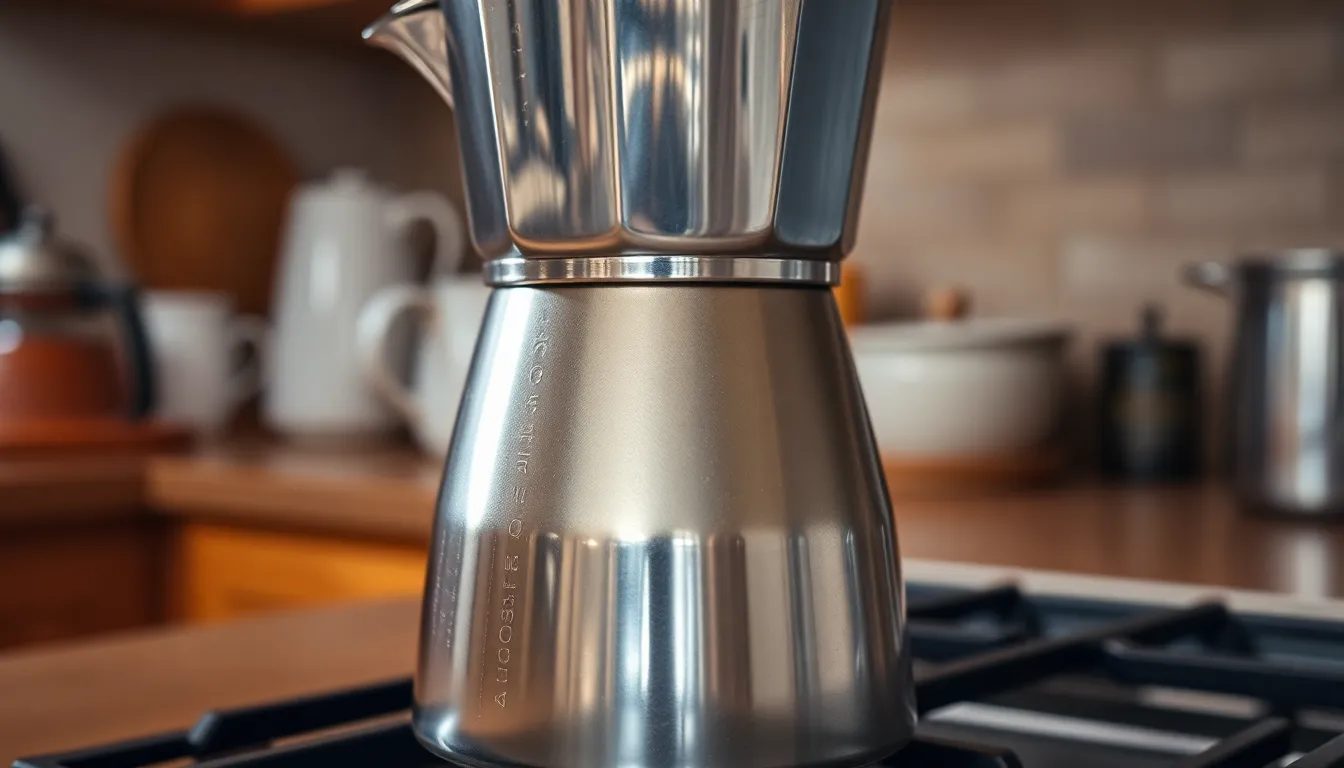
Cutting down your moka pot brewing time doesn’t mean sacrificing flavor. With a few strategic adjustments to your equipment and technique, you’ll enjoy rich, flavorful coffee in less time than the standard 5-8 minutes.
Equipment Optimization
Optimal equipment setup significantly reduces brewing time while maintaining coffee quality. Set your stovetop to medium heat rather than high to prevent fine grounds from passing through the filter, which keeps your cup clean and improves clarity. Start with water at the proper temperature—30-40°C for light roasts and 50-60°C for medium to dark roasts—to speed up extraction without compromising flavor. Check all gaskets and seals regularly to ensure they’re intact, as proper sealing maintains the pressure needed for efficient brewing and prevents frustrating leaks that extend your morning routine.
Technique Improvements
Your brewing technique plays a crucial role in how quickly your moka pot delivers great coffee. Grind your beans slightly coarser than espresso consistency—too fine a grind clogs the filter and slows down the entire process. Fill the water chamber only up to just below the safety valve to maintain safe pressure levels while optimizing brewing efficiency. Monitor the brewing process by leaving the lid open, allowing you to remove the pot from heat immediately when you hear the characteristic hissing or bubbling sound. Cooling the base immediately after brewing by rinsing it with cool water stops the extraction process and prevents bitterness from developing. These simple technique adjustments can reduce your total brewing time to about 5 minutes while improving the flavor profile of your morning coffee.
Comparing Moka Pot Brewing Time to Other Coffee Methods
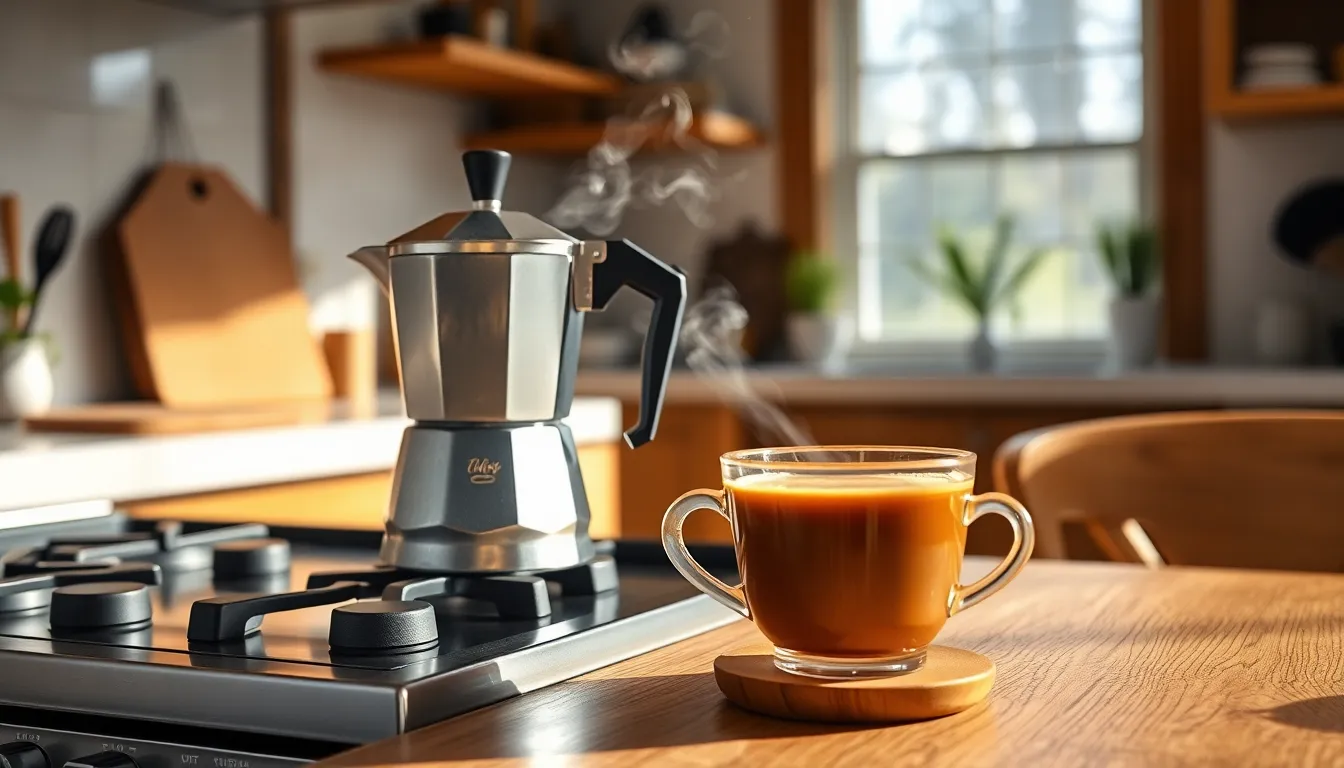
The moka pot’s brewing time of 5-10 minutes positions it in the middle range when compared to other popular coffee brewing methods. While it takes significantly longer than espresso, it’s generally faster than several other traditional brewing techniques.
Moka Pot vs. Espresso Machine
Espresso machines produce coffee in approximately 30 seconds once heated, making them about 10-20 times faster than moka pots. This dramatic difference exists because espresso machines use high-pressure pumps (9-15 bars) to force water through finely ground coffee, while moka pots rely on lower steam pressure. Even though the time difference, moka pots create a strong, concentrated brew that many consider a reasonable home alternative to espresso without the substantial investment in equipment.
Moka Pot vs. Drip Coffee Makers
Standard drip coffee makers typically complete a brewing cycle in 5-7 minutes, making them comparable to moka pots in terms of brewing duration. Drip machines produce a milder coffee than moka pots because they use gravity rather than pressure for extraction. The flavor intensity difference justifies the similar wait time, as moka pots deliver a more robust cup with higher caffeine concentration within roughly the same timeframe.
Moka Pot vs. French Press
French press brewing requires 4-5 minutes of steeping time after adding hot water to the grounds, plus additional time for water heating. The total process takes approximately 7-10 minutes, similar to a moka pot. Both methods require monitoring, but moka pots need more active attention during the brewing phase to prevent over-extraction or burning. French press produces a full-bodied brew with sediment, while moka pots deliver a cleaner, more concentrated result.
Moka Pot vs. Pour Over
Pour over methods like V60 or Chemex typically require 3-4 minutes for the actual brewing after water heating, with a total preparation time of 6-8 minutes. This places them in a similar time frame as moka pots. Pour over brewing demands more technique and continuous attention during the pour, while moka pots need careful heat management throughout the extraction process. The resulting coffee from pour over methods offers more clarity and brightness compared to the rich, bold profile of moka pot coffee.
Brewing Method Comparison Table
| Brewing Method | Active Brewing Time | Total Time (incl. prep) | Pressure Used | Flavor Profile |
|---|---|---|---|---|
| Moka Pot | 5-10 minutes | 7-12 minutes | 1-2 bars | Strong, concentrated |
| Espresso Machine | 20-30 seconds | 1-2 minutes (if preheated) | 9-15 bars | Intense, concentrated |
| Drip Coffee | 5-7 minutes | 6-8 minutes | None (gravity) | Mild, balanced |
| French Press | 4-5 minutes | 7-10 minutes | None (immersion) | Full-bodied, rich |
| Pour Over | 3-4 minutes | 6-8 minutes | None (gravity) | Clean, bright |
The moka pot strikes a balance between convenience and quality, offering substantial flavor richness within a reasonable timeframe. Its brewing duration reflects the physics of its pressure-based extraction system, delivering a distinctive coffee experience that sits between traditional drip methods and professional espresso.
Conclusion
Mastering your moka pot brewing time is all about finding the right balance between speed and flavor. With practice you’ll discover that the typical 5-10 minute process can be fine-tuned to match your personal preferences and morning schedule.
Remember that a properly brewed moka pot coffee delivers a unique experience that sits perfectly between drip coffee and espresso. The few minutes you invest in the process reward you with a rich flavorful cup that’s worth the wait.
By avoiding common mistakes and implementing the efficiency tips shared here you can create your ideal brewing routine. Whether you’re optimizing for time or taste your moka pot offers a rewarding coffee experience that has stood the test of time for good reason.
Frequently Asked Questions
How long does it take to brew coffee with a moka pot?
Brewing coffee with a moka pot typically takes 5-10 minutes from start to finish. Smaller pots (3-cup) generally brew faster (around 5 minutes), while larger pots may take up to 10 minutes. The brewing process includes 2-4 minutes of initial heating before the coffee begins to flow into the upper chamber.
What factors affect moka pot brewing time?
Several factors impact brewing time: heat source intensity (higher heat brews faster but may affect flavor), pot size (smaller pots brew quicker), grind size (too fine can clog, too coarse brews slowly), and water temperature (pre-heated water reduces brewing time). The condition of your pot’s gaskets and seals also plays a role in brewing efficiency.
Is a moka pot faster than other coffee brewing methods?
A moka pot (5-10 minutes) is significantly slower than espresso machines (30 seconds) but comparable to drip coffee makers (5-7 minutes) and slightly faster than French press (7-10 minutes) or pour-over methods (6-8 minutes). The moka pot offers a good balance between brew time and flavor intensity.
Can I speed up my moka pot brewing time?
Yes, you can reduce brewing time by using pre-heated water, applying medium heat consistently, ensuring your grind size is correct (medium-fine), not overfilling the water chamber, and keeping your pot’s gaskets in good condition. These adjustments can bring brewing time down to about 5 minutes without sacrificing flavor quality.
How much coffee should I use in a moka pot?
For a standard 6-cup moka pot, use approximately 20-22 grams of coffee with a medium-fine grind. Fill the filter basket completely but don’t tamp or compress the grounds, as this can restrict water flow and increase brewing time. The coffee should be level with the top of the basket.
How do I know when my moka pot coffee is ready?
Listen for the distinctive gurgling sound, which indicates the brewing is nearly complete. Also, watch for the coffee flow to change from dark brown to a lighter honey color. When this happens, remove the pot from heat immediately to prevent over-extraction and bitter flavors.
Why does my moka pot take too long to brew?
Your moka pot may brew slowly due to insufficient heat, starting with cold water, using too fine a grind, overfilling the water chamber, or having worn gaskets. Another common issue is using a pot that’s too large for your needs, which unnecessarily extends brewing time.
Is it better to use hot or cold water in a moka pot?
Starting with hot (not boiling) water is generally better as it reduces brewing time and prevents the coffee grounds from heating too long, which can create a burnt taste. For dark roasts, use water around 165-175°F; for medium to light roasts, use water closer to 185-195°F.

